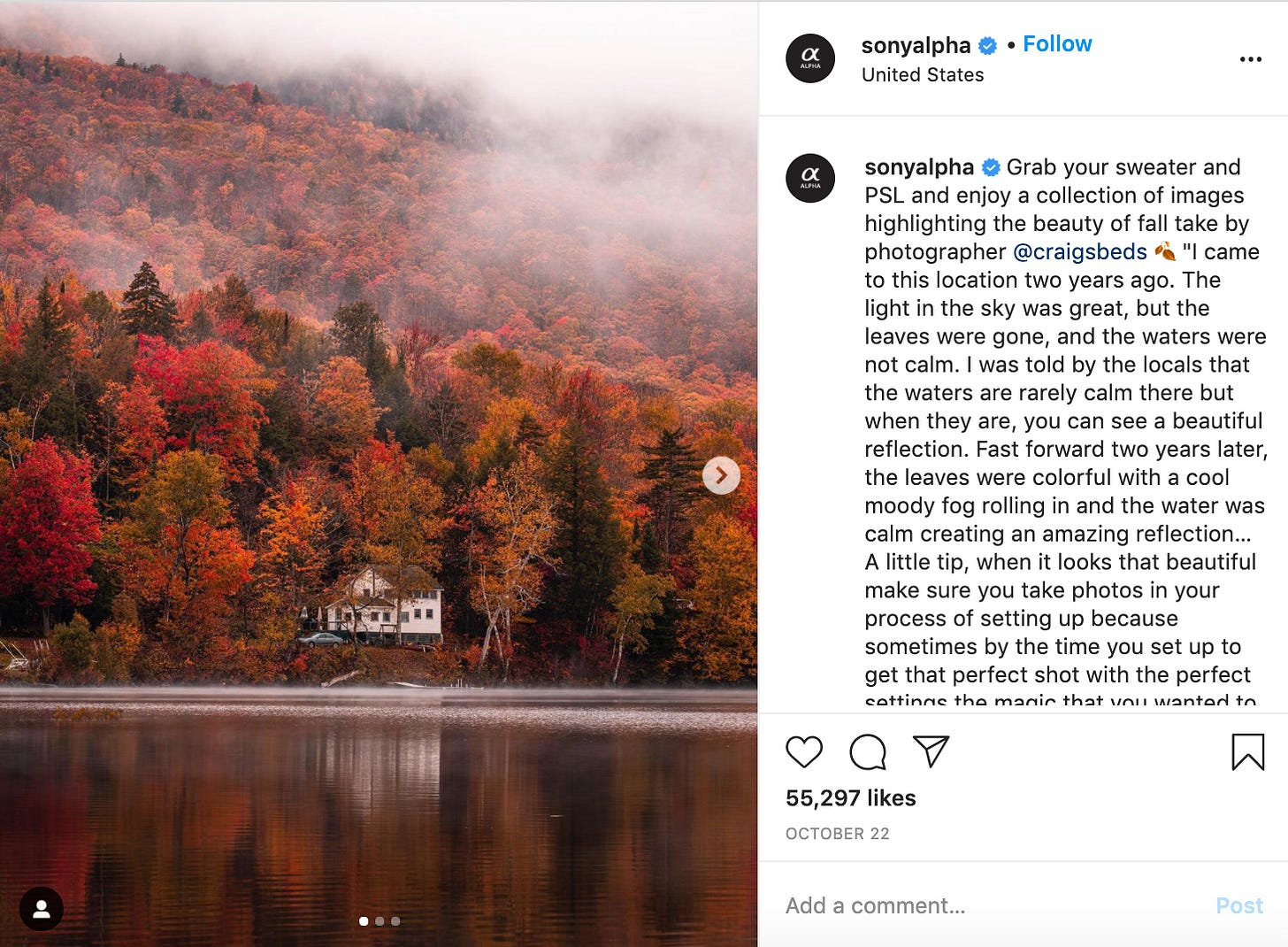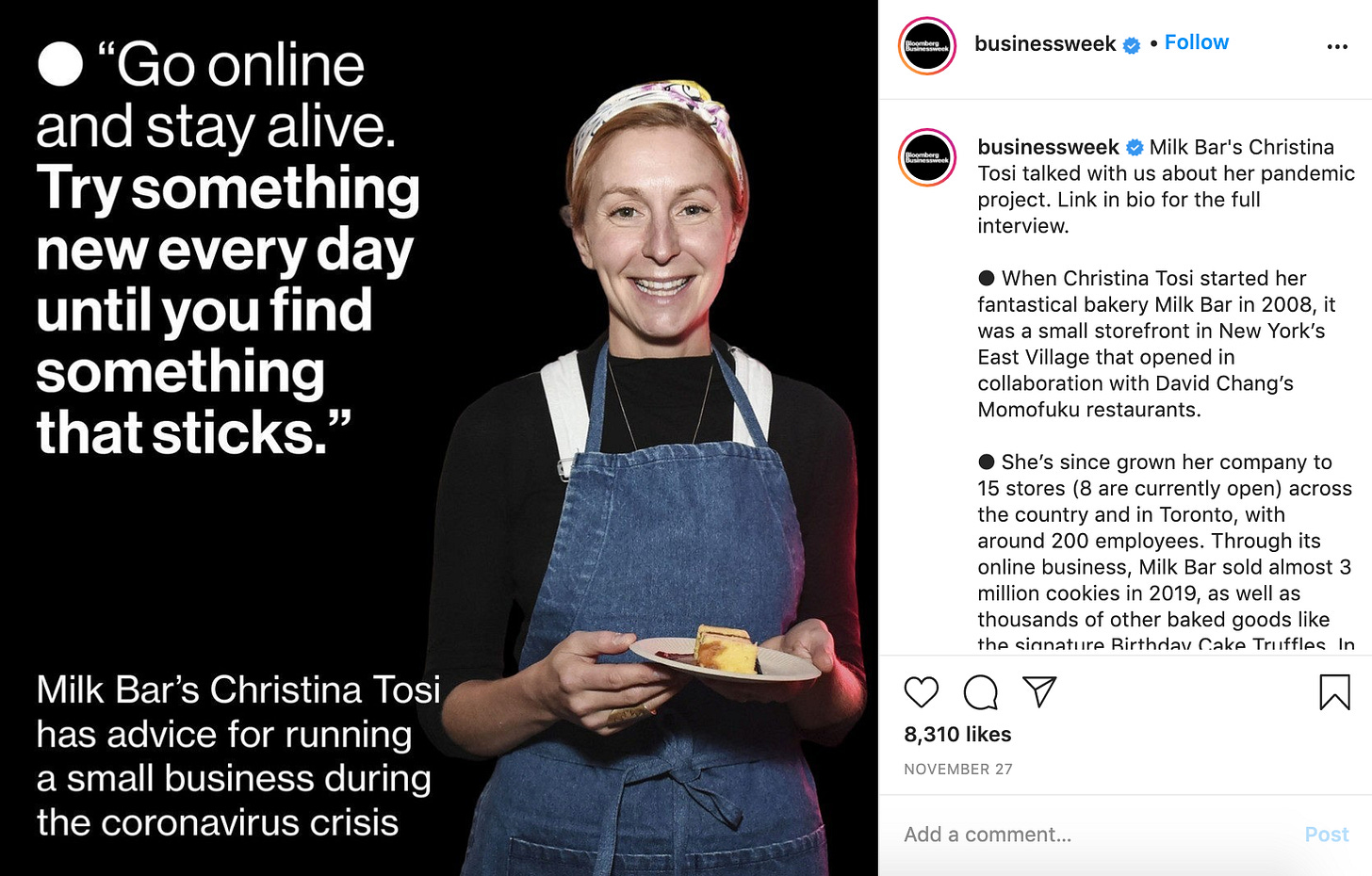#2: Using long-form captions to increase Instagram engagement
12 examples of long-form captions to inspire your 2021 strategy.
A few weeks ago, Later published an article about the best Instagram caption length for 2021. The article shared research showing that the average caption length has increased every year since 2016, and predicted that the average length for 2020 will be 405 characters (which is what they recommend as the optional caption length to use in 2021).
Moreover, the research showed that engagement jumped significantly on posts with long-form captions - from 5.4% (captions with 500-1,000 characters) to almost 6% (captions with 1,000+ characters) in 2019. Based on the study, longer captions led to more saves, comments, likes, shares, and profile clicks. Now, I'm hazarding a guess that the number of posts to analyze with >1,000 characters was much smaller than the number of posts with 0-1,000 characters, which would make the samples hard to compare side by side. Nonetheless, even posts with 500-1,000 characters averaged a 5.36% engagement rate - which is definitely a metric I'd welcome for my year-end performance review, thanks!!

Now, let's be clear: writing long-form captions is hard. And there's no guarantee that if you increase the length of your captions, your engagement will go up. Visuals will always be #1 on Instagram. However, if the photo/video is what stops someone mid-scroll, the caption is your opportunity to a) get someone to spend more time on your post (which the Instagram algorithm rewards) b) compel someone to comment and/or save your post and c) create a non-superficial relationship with your followers.
I would definitely recommend brands and social media managers to experiment with long-form captions because they allow you to:
Really showcase your brand voice (which I delved into in Case Study #1 about Netflix) through full sentences and multiple paragraphs. No single emoji captions ;)
Give something of value to your followers without them needing to leave Instagram. Yes, we all like driving website traffic, but it creates a better user experience when your followers can read something educational/helpful/interesting right in your caption. More users will see the content in your caption than who will go to your bio link - so, would you rather share something with 100% of the users who see your post, or the 1% who will go to the link in your bio?
Build a story for your brand. Whether it's talking about your brand's purpose, sharing behind-the-scenes or how-it's-made stories about your company, or sharing a first-person message from your CEO, this sort of content helps build a relationship with your fans and followers who take the time to read it.
One more thing: In November, Instagram announced the upcoming launch of keyword search. With the new feature, users will be able to find posts through words or phrases, not just hashtags or locations. If you're familiar with SEO, this has pretty big implications for brands - as users will be able to discover posts not just passively through their newsfeed/Stories, but now through actively searching, similar to Pinterest. So, having more keywords in long-form captions will give your posts better discoverability/reach, and potentially more engagement and new followers.
So, to get you inspired for how to use long-form captions for your brand, I've rounded up 12 examples from brands and creators that do good long-form captions.
1) @reneeroaming (travel photographer & blogger)
Caption length: 1,136 characters/196 words
Key points:
writes microblogs within her captions with useful tips that are relevant to her audience (pulling from her skills as a blogger)
uses bullet points to tease key points from the full post, providing a compelling reason to go to the bio link
explicit CTA to 'save' the post (which increases engagement rate and makes sure her followers see more of these posts in the future)
actionable tips right within the caption, which makes it share-worthy and follow-worthy to new people who come across her account
2) @sonyalpha (retail brand)
Caption length: 1,183 characters/219 words
Key points:
as this is a UGC photo, they list the original photographer at the beginning of the caption (which I think is important, rather than at the end of a long caption which not all people will read)
explains in detail the process behind how the photo was captured (which is super interesting for photographers and something that they would take the time to read)
lists the camera settings and model (subtle product plug yet also helpful info for photographers)
wish they used line breaks to make it more readable!
3) @hubspotacademy (B2B SaaS)
Caption length: 608 characters/95 words
Key points:
shares key content in emoji bullet-point lists, which is eye-catching and makes the caption easily digestible
"link in bio" CTA at the beginning of the caption - as the visual already gives away the headline of the article, the reader may already be intrigued enough to go to the bio link
relatively short, but still much more valuable and attention-grabbing than a caption with the article headline + "link in bio"
4) @businessweek (publisher)
Caption length: 1,333 characters/233 words
Key points:
"link in bio" CTA at beginning and end of the caption - as a publisher, they want to drive visits to their website so it's worth repeating the CTA at the beginning (when attention is highest) and at the end (in case the reader didn't catch it at the beginning)
they use emojis to start each paragraph and break up the long caption
@businessweek's captions need to strike a balance between being engaging but not giving away so much that the reader wouldn't interested to read the full article
5) @againstthecompass (travel blogger)
Caption length: 2,000+ characters/378 words
Key points:
uses long caption to genuinely educate followers about a specific destination with multiple examples to illustrate his point
poses questions then answers them within the caption to keep the reader engaged and make it feel like a real conversation
CTA at the end (encourages comments)
lots of short paragraphs/line breaks - which makes the caption longer to scroll through, but also easier to comprehend
6) @yoursocialteam (business coach)
Caption length: 1,212 characters/205 words
Key points:
uses a long-form caption to create a list of accounts (and why they belong on the list)
CTA is for followers to comment with which accounts they would add to the list
I like that the post visual complements the caption as a 10-slide carousel tagging the same 10 accounts listed in the caption
7) @bylisakitahara & @cookerru (recipe bloggers)
Caption length: 950 characters/185 words
Key points:
uses long-form captions to list out the ingredients + instructions for her recipes
mostly uses long-form captions on reels/videos, which makes sense as viewers who are willing to spend the time watching the video are also more likely to read the whole caption
example from another recipe blogger - after the "link in bio" CTA, she adds her username so that readers don't have to scroll all the way back up and click her username to go to her bio link
8) @wsj (publisher)
Caption length: 2,000+ characters/383 words
Key points:
no preamble or headline; the caption dives straight into the content
the caption is a mix of paragraphs taken directly from the full article
9) @nationalparkservice (government agency)
Caption length: 1,099 characters/197 words
Key points:
often incorporates puns or wordplay into the captions, like the pun in this one (which results in joyful comments)
it's a rare example on this list without any "link in bio" CTA - so all the value is derived from the caption itself, which is all the more reason to use long-form captions
alt text is included within the caption itself (in addition to the image), which really ensures accessibility
10) @theconsciouskid (education)
Caption length: 1,939 characters/318 words
Key points:
post format: essentially a long & detailed book review
highlights the author's username at the top (important, given the nature of the post is to support the author)
more than just a book description; includes excerpts from the book, name drops of people featured in the book, why you should read it, and where you can get it
11) @lushcosmetics (retail brand)
Caption length: 448 characters/82 words
Key points:
ok so this one is a little on the short side, but I love that they used their caption to do a quiz!
even more clever that they encourage two engagements: either viewing Lush's Instagram Story or leaving a comment with their guess (which Lush can then reply to and create a pinned comment with the right answer)
12) @humansofny (photographer/storyteller)
Caption length: 1,742 characters/339 words
Key points:
HONY is perhaps the pioneer of long-form captions on social posts! Read one and you'll understand why the format works. Sure Brandon is a great photographer, but HONY's magic is in the stories told via the captions (and if you haven't read the full 32-post series about Stephanie/Tanqueray, go read it after this)
the components are very simple: quotation marks (to signal it's being quoted from the person in the photo) and a 1/## if it's a multi-post series
In summary, here are 5 tips for how your brand can use long-form captions in 2021:
If you want users to visit your bio link, add your @handle at the end of the caption. Keep in mind that longer captions = more scrolling, so eliminate the need to scroll up again just to click your username.
Use blog/article excerpts as your captions. No need to write separate social copy!
Write microblogs in the caption. Use bullet point lists and headlines to format your caption just like a blog, and encourage users to save or share your post.
Break up long captions with line breaks. Keep paragraphs short, and be liberal with your ¶s as it'll help make long captions easier to read. Just don't go full-LinkedIn influencer (aka one word/sentence per paragraph).
Consider adding your CTA at the beginning and end of the caption. This is beneficial for the users who will only read the first line(s) of your caption, and for the users who will read the full caption but might forget about the CTA by the time they get to the end.













